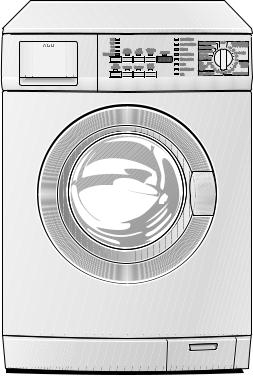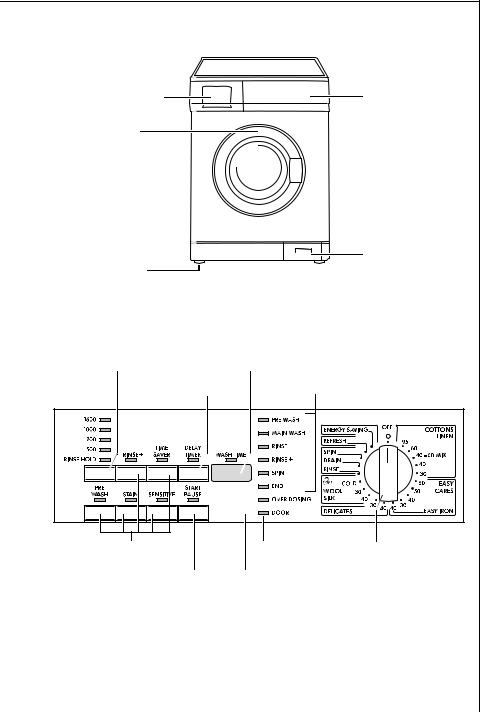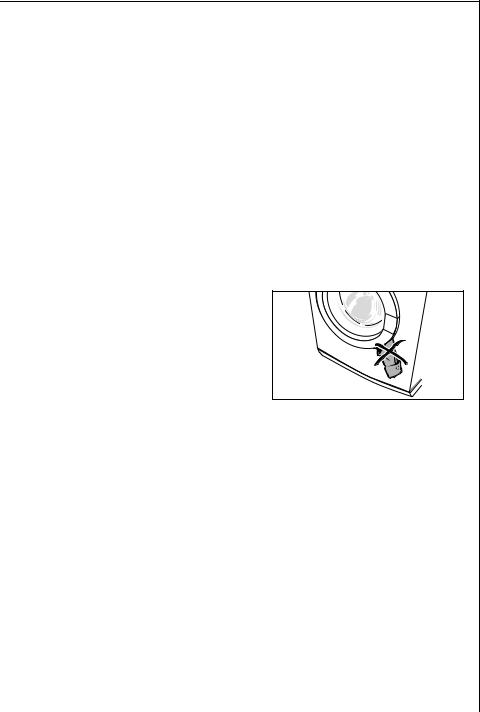AEG LAVAMAT 76800 User Manual

LAVAMAT 76800
Washing Machine
User information

Dear Customer,
Please read this user information carefully and keep it to refer to later. Please pass the user information on to any future owner of the appliance.
The following symbols are used in the text:
1 Safety instructions
Warning! Information that affects your personal safety. Important! Information that prevents damage to the appliance.
3 Useful tips and hints
2 Environmental information
2

Contents |
|
Operating Instructions. . . . . . . . . . . . . . . . . . . . . . . . . . . . . . . . . . . . . |
5 |
Safety . . . . . . . . . . . . . . . . . . . . . . . . . . . . . . . . . . . . . . . . . . . . . . . . . . . . . . . . . |
5 |
Disposal . . . . . . . . . . . . . . . . . . . . . . . . . . . . . . . . . . . . . . . . . . . . . . . . . . . . . . . |
6 |
Description of the appliance . . . . . . . . . . . . . . . . . . . . . . . . . . . . . . . . . . . . |
7 |
Control panel . . . . . . . . . . . . . . . . . . . . . . . . . . . . . . . . . . . . . . . . . . . . . . . . . . |
7 |
Programme overview . . . . . . . . . . . . . . . . . . . . . . . . . . . . . . . . . . . . . . . . . . . . |
8 |
Before the first wash. . . . . . . . . . . . . . . . . . . . . . . . . . . . . . . . . . . . . . . . . . . . |
10 |
Preparing and sorting washing . . . . . . . . . . . . . . . . . . . . . . . . . . . . . . . . . . . |
10 |
Running a wash cycle . . . . . . . . . . . . . . . . . . . . . . . . . . . . . . . . . . . . . . . . . . . |
11 |
Opening the door/loading washing . . . . . . . . . . . . . . . . . . . . . . . . . . . . . . . . . |
11 |
Adding detergent /conditioner . . . . . . . . . . . . . . . . . . . . . . . . . . . . . . . . . . . . |
11 |
Switching on the appliance/selecting a programme . . . . . . . . . . . . . . . . . . . |
13 |
Changing the spin speed/selecting rinse hold . . . . . . . . . . . . . . . . . . . . . . . . |
13 |
Selecting additional programmes . . . . . . . . . . . . . . . . . . . . . . . . . . . . . . . . . . |
14 |
RINSE + . . . . . . . . . . . . . . . . . . . . . . . . . . . . . . . . . . . . . . . . . . . . . . . . . . . . . |
14 |
TIME SAVER. . . . . . . . . . . . . . . . . . . . . . . . . . . . . . . . . . . . . . . . . . . . . . . . . . |
14 |
PRE WASH . . . . . . . . . . . . . . . . . . . . . . . . . . . . . . . . . . . . . . . . . . . . . . . . . . . |
14 |
STAIN . . . . . . . . . . . . . . . . . . . . . . . . . . . . . . . . . . . . . . . . . . . . . . . . . . . . . . . |
14 |
SENSITIVE . . . . . . . . . . . . . . . . . . . . . . . . . . . . . . . . . . . . . . . . . . . . . . . . . . . |
14 |
Setting the delay timer . . . . . . . . . . . . . . . . . . . . . . . . . . . . . . . . . . . . . . . . . . . |
15 |
Starting a programme . . . . . . . . . . . . . . . . . . . . . . . . . . . . . . . . . . . . . . . . . . . . |
15 |
Programme sequence . . . . . . . . . . . . . . . . . . . . . . . . . . . . . . . . . . . . . . . . . . . . |
15 |
Interrupting a programme/adding washing . . . . . . . . . . . . . . . . . . . . . . . . . . |
16 |
End of the wash cycle/removing the washing . . . . . . . . . . . . . . . . . . . . . . . . |
16 |
Overdosing . . . . . . . . . . . . . . . . . . . . . . . . . . . . . . . . . . . . . . . . . . . . . . . . . . . . . |
16 |
Child safety device. . . . . . . . . . . . . . . . . . . . . . . . . . . . . . . . . . . . . . . . . . . . . . |
17 |
Cleaning and care . . . . . . . . . . . . . . . . . . . . . . . . . . . . . . . . . . . . . . . . . . . . . . |
18 |
What to do if.... . . . . . . . . . . . . . . . . . . . . . . . . . . . . . . . . . . . . . . . . . . . . . . . . |
19 |
Remedying small faults yourself . . . . . . . . . . . . . . . . . . . . . . . . . . . . . . . . . . . |
19 |
If the wash result is not satisfactory . . . . . . . . . . . . . . . . . . . . . . . . . . . . . . . . |
21 |
Carrying out an emergency drain . . . . . . . . . . . . . . . . . . . . . . . . . . . . . . . . . . |
22 |
Drain pump. . . . . . . . . . . . . . . . . . . . . . . . . . . . . . . . . . . . . . . . . . . . . . . . . . . . . |
23 |
Technical data. . . . . . . . . . . . . . . . . . . . . . . . . . . . . . . . . . . . . . . . . . . . . . . . . . |
24 |
Consumption values. . . . . . . . . . . . . . . . . . . . . . . . . . . . . . . . . . . . . . . . . . . . . |
24 |
3

Installation and connection instructions. . . . . . . . . . . . . . . . . 25
Safety information concerning installation . . . . . . . . . . . . . . . . . . . . . . . . 25
Installing the appliance . . . . . . . . . . . . . . . . . . . . . . . . . . . . . . . . . . . . . . . . . 26 Transporting the appliance . . . . . . . . . . . . . . . . . . . . . . . . . . . . . . . . . . . . . . . . 26 Removing the transit packaging . . . . . . . . . . . . . . . . . . . . . . . . . . . . . . . . . . . 26 Where to install . . . . . . . . . . . . . . . . . . . . . . . . . . . . . . . . . . . . . . . . . . . . . . . . . 27 Making the appliance level. . . . . . . . . . . . . . . . . . . . . . . . . . . . . . . . . . . . . . . . 28
Electrical Connection . . . . . . . . . . . . . . . . . . . . . . . . . . . . . . . . . . . . . . . . . . . |
29 |
Connecting the appliance to the water supply . . . . . . . . . . . . . . . . . . . . . 30 Water inlet . . . . . . . . . . . . . . . . . . . . . . . . . . . . . . . . . . . . . . . . . . . . . . . . . . . . . 31 Water Drainage . . . . . . . . . . . . . . . . . . . . . . . . . . . . . . . . . . . . . . . . . . . . . . . . . 32
Warranty conditions . . . . . . . . . . . . . . . . . . . . . . . . . . . . . . . . . . . . . . . |
34 |
Service and Spare Parts . . . . . . . . . . . . . . . . . . . . . . . . . . . . . . . . . . . 35
4

Operating Instructions
1 Safety
Prior to using the appliance for the first time
•Follow the “Installation and connection instructions”.
•If the appliance is delivered in the winter months when there are minus temperatures: store the washing machine at room temperature for 24 hours before using for the first time.
Correct use
•The washing machine is only designed for the washing of normal domestic laundry at home.
•Additions or modifications to the washing machine are not permitted.
•Only use detergents/conditioners that are suitable for use in domestic washing machines.
•The washing must not contain any flammable solvent. The risk of explosion exists.
•Do not use the washing machine for dry cleaning.
•Dyes/colour removers may only be used in the washing machine, if the manufacturer of these products expressly permits this. We cannot accept liability for any damage arising.
Child safety
•Keep packaging away from children. There is a risk of suffocation.
•Children often do not recognise the hazards associated with electrical appliances. Don’t allow children to use the washing machine unsupervised.
•Make sure that children and pets don’t climb into the drum of the washing machine. The risk of death exists.
General safety
•Repairs to the washing machine may only be carried out by qualified/ authorised service engineers.
•Never use the appliance when the electrical cable is damaged or the control panel, worktop or plinth area are damaged to such an extent that the inside of the appliance is openly accessible.
5

•Switch off the washing machine prior to cleaning it and carrying out maintenance. In addition, remove the power plug from the power point or – if the appliance has been hard-wired – switch off the cutout in the fuse box or completely remove the fuse.
•If operation is stopped, disconnect the appliance from the mains supply and turn off the tap.
•Never remove the power plug from the power point by pulling on the cable. Always pull the plug.
•Multiway-plugs, connectors and extension cables must not be used.
Resulting overheating may constitute a fire hazard.
•Never wash the washing machine down with a water jet. Danger of electric shock.
•When using wash programmes with high temperatures the glass in the door will become hot. Do not touch it!
•Before emergency emptying of the appliance, before cleaning the drain pump or opening the door in an emergency, let the water cool down.
•Small animals can nibble on electrical cables and water hoses. This can constitute a risk of electrocution and water damage. Keep small animals away from the washing machine.
Disposal
2 Packaging material
The packaging materials are environmentally friendly and can be recycled. The plastic components are identified by markings, e.g. >PE<, >PS<, etc. Please dispose of the packaging materials in the appropriate container at your local waste disposal facilities.
2 Old appliance
Please dispose of your old appliance in line with the guidelines for disposal in your area.
1 Warning: When your appliance has finished its working life, remove the plug from the mains socket. Cut off the cable and plug and dispose of them.
Destroy the door lock. This prevents children from trapping themselves inside and endangering their lives.
6

Description of the appliance |
|
||
Detergent drawer |
|
|
Control panel |
Rating plate |
|
|
|
(behind door) |
|
|
|
Screw feet |
|
|
Plinth flap/ |
|
|
Drain pump |
|
(height adjustable) |
|
|
|
Control panel |
|
|
|
Spin/RINSE HOLD button |
|
Multi-display |
|
DELAY TIMER button |
Programme progress display |
||
Additional programme |
|
DOOR indicator |
Programme selector |
buttons |
|
|
|
START/PAUSE button |
OVERDOSING indicator |
|
|
|
|
|
7 |

Programme overview
|
|
Additional programmes |
|
Spin speed |
|
|
||||||
Programme |
loadmax. washing)(dry |
+RINSE |
SAVERTIME |
WASHPRE |
STAIN |
SENSITIVE |
1600 |
1000 |
700 |
500 |
HOLDRINSE |
|
1) |
|
|
|
|
|
|
|
|
|
|
||
ENERGY SAVING2) |
6kg |
• |
- |
• |
• |
• |
• |
• |
• |
• |
• |
|
COTTONS/LINEN |
6kg |
• |
• |
• |
•3) |
• |
• |
• |
• |
• |
• |
|
95, 60, 40, 30 |
||||||||||||
|
|
|
|
|
|
|
|
|
|
|
||
40-60 MIX |
6kg |
• |
- |
• |
• |
• |
• |
• |
• |
• |
• |
|
EASY-CARES |
3kg |
• |
• |
• |
•3) |
• |
- |
• |
• |
• |
• |
|
60, 50, 40, 30 |
|
|
|
|
|
|
|
|
|
|
|
|
EASY IRON 40 |
1kg |
• |
• |
• |
• |
- |
- |
• |
• |
• |
• |
|
DELICATES |
3kg |
• |
• |
• |
- |
- |
- |
• |
• |
• |
• |
|
40, 30 |
||||||||||||
|
|
|
|
|
|
|
|
|
|
|
||
WOOL/SILK H (Hand-washing) |
2kg |
- |
- |
- |
- |
- |
- |
• |
• |
• |
• |
|
40, 30, COLD |
||||||||||||
|
|
|
|
|
|
|
|
|
|
|
||
RINSE |
3kg |
- |
- |
- |
- |
- |
- |
• |
• |
• |
• |
|
DRAIN |
- |
- |
- |
- |
- |
- |
- |
- |
- |
- |
- |
|
|
|
|
|
|
|
|
|
|
|
|
|
|
SPIN |
6kg |
- |
- |
- |
- |
- |
• |
• |
• |
• |
- |
|
REFRESH |
3kg |
- |
- |
- |
- |
- |
- |
• |
• |
• |
• |
|
|
|
|
|
|
|
|
|
|
|
|
|
|
1)A 10 litre bucket contains approx. 2.5 kg dry washing (cotton)
2)Programme settings for tests in accordance with or in the style of EN 60 456 and IEC 60 456 are described in the chapter “Consumption values”.
3)STAIN can only be set from 40° upwards, as stain removal agent only becomes effective at higher temperatures.
8

Application/Features |
Care |
symbols1) |
|
Energy-saving programme which washes at 60 °C for lightly to normally soiled |
MO |
whites or coloureds made of cotton/linen. |
|
Programme for normally to heavily soiled whites/coloureds made of cotton/linen. |
JMO |
Programme for cottons/linen, which is indicated for various wash temperatures. |
JM |
Items which according to their care label are normally washed separately at 40 °C or |
|
at 60 °C, can be washed together in this programme. In this way the drum capacity is |
|
better used, saving energy. Due to the increased wash time a wash result equivalent |
|
to that of a normal 60° programme is achieved. |
|
Programme for easy-care mixed fibres and synthetics. |
IKN |
|
|
Special programme which washes at 40 °C for easy-care fabrics which after being |
KN |
washed using this programme need to be ironed only lightly or not at all. |
|
Gentle programme for delicate textiles such as bonded fibres, micro-fibres, synthet- |
IK |
ics, net curtains (load max. 20 to 25 m2 curtains). If used together with RINSE HOLD, |
|
also suitable for fabrics with climatic membranes, e.g. outdoor clothing. |
|
Specially gentle programme for machine and hand-washable wool/silk. |
QLH |
|
|
Separate gentle rinse (3 rinse cycles, liquid conditioner is washed in from the |
IKN |
compartment &, gentle spin). |
QLH |
Draining following a rinse hold. |
|
|
|
Draining and spinning, e.g. following a rinse hold, or separate spinning of hand- |
JMO |
washed cottons/linen. |
|
Special programme which washes at 30 °C, approx. 30 minutes, for brief washing of |
JMO |
e.g. worn-once, lightly soiled sports clothing or new clothes. |
IKN |
|
|
1) The figures in the care symbols indicate the maximum temperatures.
9

Before the first wash
To remove any production-related residues from the drum and water tank, perform the first wash cycle without washing. Programme: COTTONS/LINEN 60, press the TIME SAVER button, add approx. 1/4 measuring cup of detergent.
Preparing and sorting washing
Preparing washing
•Empty the pockets. Remove foreign bodies (e.g. coins, paper clips, nails, etc.).
•Do up zips, button up covers to prevent damage to washing.
•Remove the runners from net curtains or cover them with a net or a bag.
•Wash delicate and small items in a net/pillowcase, e. g. net curtains, tights, small socks, handkerchiefs, bras.
Important: Bras and other items containing wires should only be washed in a net bag. The wires can work loose and damage the appliance.
Sorting washing
•By colour: Wash white and coloured washing separately. Washing can run.
•By temperature, type of washing and care symbol.
Important: Do not wash fabrics with the Gcare symbol (= do not wash!) in the washing machine.
10

Running a wash cycle
Opening the door/loading washing
1.Open the door: pull the handle on the door.
When the appliance is switched on, the DOOR and START/PAUSE indicators show whether the door can be opened:
DOOR indicator |
START/PAUSE indicator Can the door be opened? |
||
illuminated green |
flashing red or not illumi- |
yes |
|
nated |
|||
|
|
||
illuminated green |
illuminated red |
yes, after pressing the |
|
START/PAUSE button |
|||
|
|
||
|
|
|
|
During the programme the door is locked when the water level or the temperature is high. The DOOR indicator is not illuminated.
2. Separate washing and load it loosely. Mix large and small items. Important: Do not get any washing caught between the door and the rubber seal.
3.Firmly push the door shut. Door catch must audibly click shut.
Adding detergent /conditioner
Important: Only use detergents/conditioners that are suitable for use in household washing machines.
Add detergent/conditioner in accordance with the detergent/conditioner manufacturer’s instructions. Observe instructions on the packaging.
The amount of detergent used depends on:
–the degree of soiling,
–the load size
–the hardness of the tap water.
•If the manufacturer does not make any recommendations with regard to small volumes of washing: For a half-load use a third less, and for a very small load use only the half the amount of detergent that is recommended for a full load.
•Water softener should be used from water hardness range 2 (=medium). The amount of detergent used can then always be that as for hardness range 1 (=soft). Your local water company will provide you with information about water hardness in your area.
11
